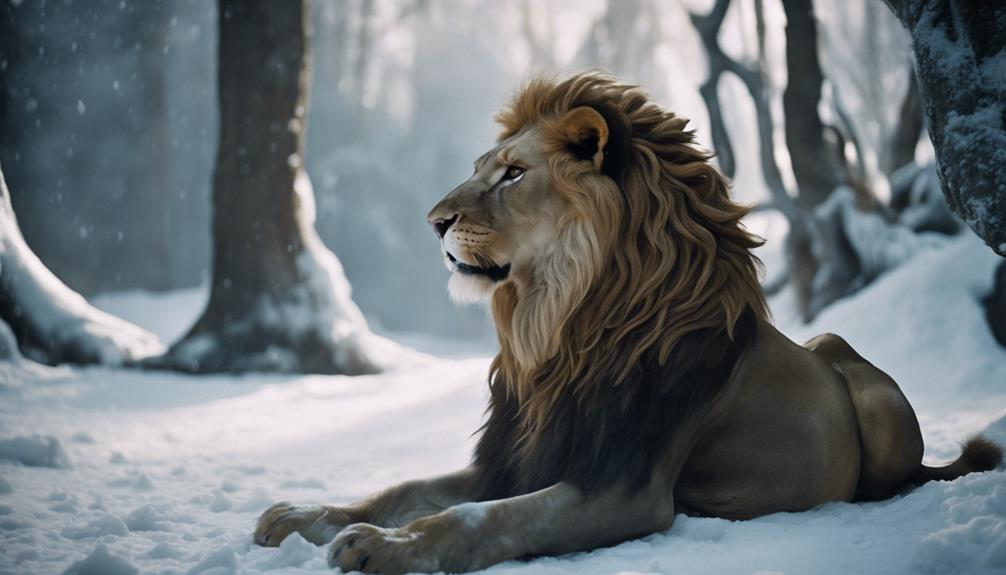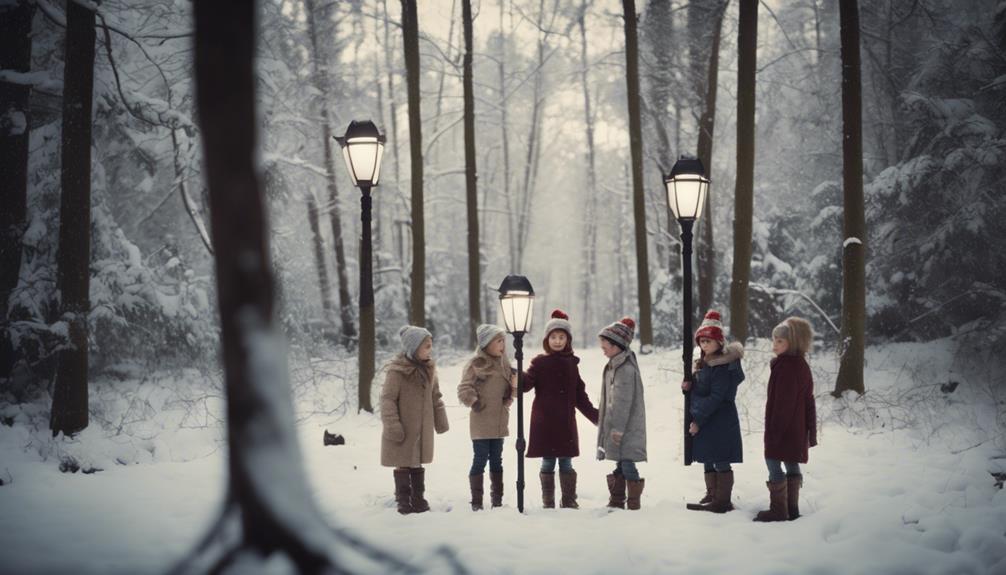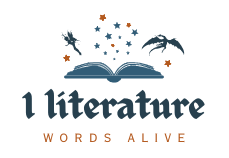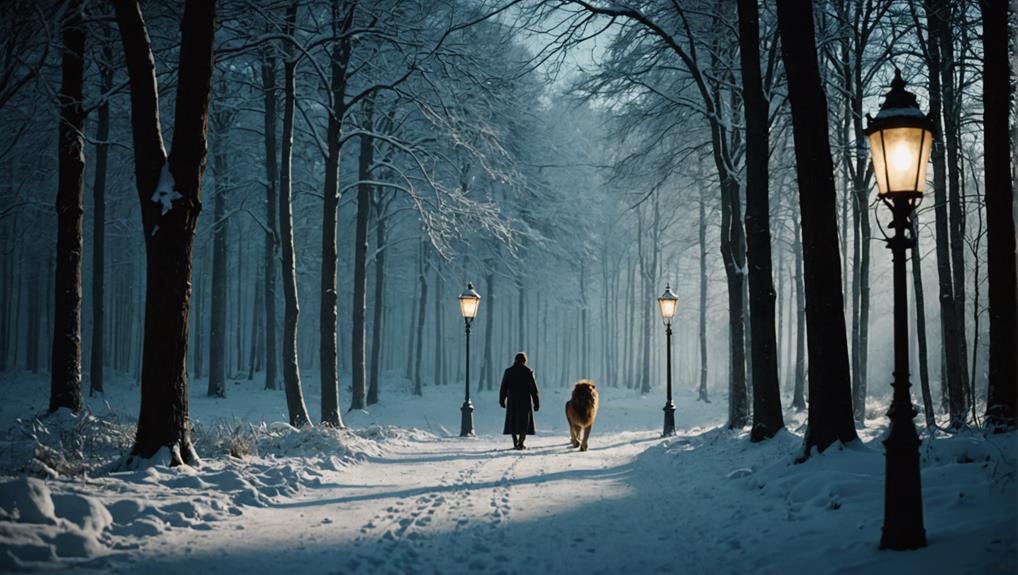Step through the creaking wardrobe doors into a world where magic dances in the air and whispers through the snowy woods of Narnia. The allure of 'The Lion, the Witch, and the Wardrobe' lies not just in its fantastical setting but in the intricate tapestry of enchantments that shape destinies and test courage. As you uncover the layers of magic woven into the very essence of this timeless tale, you'll discover a world where wonders and dangers coexist, beckoning you to explore the depths of its mysteries and the truths it holds.
Background
Explore the origins and significance of the Deep Magic in 'The Lion, the Witch, and the Wardrobe' to understand its pivotal role in shaping the narrative.
The Deep Magic in Narnia traces back to the Emperor-beyond-the-Sea during the Dawn of Time, granting the White Witch the authority to execute traitors. This ancient law posed a grave threat to Narnia's inhabitants, with the potential for the land's destruction if disobeyed.
However, Aslan intervened using the Deeper Magic from before Time's Dawn to rescue Edmund Pevensie from the White Witch's claim, showcasing a higher power at play.
Scholars often highlight the Christian allegorical elements intertwined with the Deep Magic, adding layers of depth to the narrative.
Despite its vital role in the first book of the Chronicles of Narnia series, the Deep Magic's influence remains confined to its initial invocation, leaving a lasting impact on the characters and the course of events.
Magic Users
Magic users in 'The Lion, the Witch, and the Wardrobe' wield diverse and powerful abilities, shaping the fantastical world of Narnia. Among them, the White Witch, known as Jadis, stands out as a formidable figure who commands deep magic in Narnia. Her abilities extend to controlling life, elements, and casting potent spells that influence the very fabric of the world.
On the other hand, Aslan, the majestic lion and deity in Narnia, showcases magical prowess through acts like resurrection, creation, and manipulation of mystical forces. Additionally, Lucy, a human character, proves that even humans can learn and wield magic in Narnia, displaying a unique connection to the magical essence of the world.
These magic users exhibit a wide range of capabilities, from casting spells and controlling elements to summoning beings and performing extraordinary feats like resurrection and invisibility, enriching the enchanting tapestry of 'The Lion, the Witch, and the Wardrobe'.
Types of Magic

Types of magic wielded in 'The Lion, the Witch, and the Wardrobe' encompass a diverse array of mystical abilities held by various magical beings in the enchanting world of Narnia. True magicians in Narnia, such as nymphs, hags, fairies, witches, and deities, exhibit unique magical talents ranging from spellcasting to elemental control.
Deep magic, known as the Deeper Magic, forms the fundamental laws essential for the world's existence, regulating the balance of power and order in Narnia.
Humans in Narnia lack innate magical abilities but can acquire magical skills through learning in the enchanting domains of magical worlds. Magic users in Narnia demonstrate the ability to cast spells, manipulate elements, and craft intricate illusions, showcasing the breadth of magical aptitudes present in this fantastical domain.
Aslan, the powerful deity and guardian of Narnia, is deeply connected to the magical fabric of the world, overseeing and influencing the magical elements that permeate throughout the land, even playing a pivotal role in events like his resurrection.
Uses of Magic
Various characters in 'The Lion, the Witch, and the Wardrobe' harness magic for diverse purposes, showcasing a range of mystical abilities within the enchanting world of Narnia. Magic from the Dawn of time plays a pivotal role, as seen through the resurrection of Aslan at the Stone Table. This ancient magic involves deep laws that govern Narnia's existence, ensuring balance and order.
Characters like Lucy utilize magic to heal and bring light, while Jadis, the White Witch, wields it for darker purposes like mind manipulation and creating illusions to deceive others. Moreover, magical beings like Aslan demonstrate immense powers, from controlling elements to summoning aid when needed.
Bacchus, the god of wine, showcases magic through celebrations and blessings. Even the talking animals in Narnia possess magical abilities, such as the ability to communicate with humans and each other through a shared mystical connection. In 'The Lion, the Witch, and the Wardrobe', magic serves as a versatile tool used by various characters for both good and evil purposes, adding depth and wonder to the story's enchanting world.
Plot and Characters

Entering the fantastical realm of Narnia through a wardrobe during the Blitz, the children embark on a magical adventure filled with danger and awe. Lucy Pevensie, along with her siblings Edmund, Susan, and Peter, discover the enchanted land of Narnia, where the White Witch's evil magic has plunged the world into eternal winter. The Narnia series unfolds with the children's journey to break the curse, learning valuable lessons of bravery and sacrifice along the way.
As they encounter mystical creatures and face challenging obstacles, the characters develop and grow, each playing a vital role in the battle against the White Witch.
Central to the plot is Aslan, the majestic lion who sacrifices himself to save Edmund from the White Witch's clutches. His resurrection marks a pivotal moment in the story, showcasing the transformative power of magic in Narnia.
After defeating the White Witch, the children are crowned as the rulers of Narnia, solidifying their place in the magical world they helped save.
Author and Reception
C.S. Lewis wrote 'The Lion, the Witch, and the Wardrobe' in 1950, marking the beginning of The Chronicles of Narnia series. The book, dedicated to his goddaughter Lucy Barfield, is revered as one of the best English-language novels. Its timeless appeal has garnered widespread acclaim, earning a spot on Time magazine's 100 Best Young-Adult Books list and ranking ninth in BBC's The Big Read poll in 2003.
Readers of all ages continue to be enchanted by the novel's profound themes of sacrifice, redemption, and bravery. Lewis's masterful storytelling and vivid imagination have ensured that 'The Lion, the Witch, and the Wardrobe' remains a beloved classic in children's literature.
The novel's reception has been nothing short of extraordinary, with its influence extending far beyond the pages of the book. 'The Lion, the Witch, and the Wardrobe' has left an indelible mark on literary culture, inspiring countless adaptations and merchandise, solidifying its place as a timeless masterpiece that continues to captivate hearts around the world.
Legacy and Impact

You'll see how 'The Lion, the Witch, and the Wardrobe' has left a lasting mark on culture and literature.
Its symbolism and themes continue to resonate with audiences worldwide.
The impact of this classic story goes beyond entertainment, touching on deeper aspects of sacrifice, redemption, and courage.
Enduring Cultural Influence
The lasting cultural influence of 'The Lion, the Witch, and the Wardrobe' is evident in its widespread adaptations and continued resonance with audiences worldwide. The World of Narnia, brought to life by C.S. Lewis, has captivated readers for generations, making it one of the best children's literature classics.
From the iconic White Witch to the majestic Aslan, the characters have ingrained themselves in popular culture and literary analysis.
The book's impact extends beyond the pages, inspiring various adaptations in TV, film, and stage productions. Its themes of sacrifice and redemption have struck a chord with readers of all ages, contributing to the development of the fantasy genre.
Additionally, the Christian allegorical elements woven into the narrative have sparked scholarly interest and diverse interpretations. 'The Lion, the Witch, and the Wardrobe' continues to enchant audiences worldwide, ensuring its enduring legacy in the world of literature and popular culture.
Symbolism and Resonance
The symbolism and resonance of 'The Lion, the Witch, and the Wardrobe' stem from its profound impact on readers and the enduring legacy it has carved within the domains of literature and popular culture. Here's why:
- The Christian themes woven throughout the narrative, particularly in Aslan's sacrifice and resurrection, provide a deep sense of symbolism that resonates with readers on a spiritual level.
- The representation of magic in the form of the Deep Magic and Deeper Magic in Narnia serves as a metaphor for Natural Law and divine intervention, adding layers of complexity to the story's themes.
- The way magic is utilized as a narrative tool by C.S. Lewis enhances the reader's engagement with the text, allowing for a deeper exploration of concepts like sacrifice and the battle between good and evil.
Adaptations and Allusions
Exploring the adaptations and allusions of 'The Lion, the Witch, and the Wardrobe' adds depth to its timeless narrative. This beloved tale has been brought to life through various adaptations for television, stage, and film, underscoring its enduring popularity.
Notable TV adaptations in 1967, 1979, and 1988 have been praised for their quality and faithfulness to the source material. The 2005 theatrical film adaptation also resonated with audiences, becoming a commercial success and reaching a wide viewership.
One of the key aspects that these adaptations often highlight is the allusion to Christian themes, particularly seen in Aslan's sacrificial act. This poignant element adds layers of meaning to the story, emphasizing themes of redemption and selflessness.
Beyond its religious undertones, 'The Lion, the Witch, and the Wardrobe' has also left a mark on popular culture, showcasing its cultural significance through educational impact and recognition in various surveys and polls. The story's ability to transcend literature and resonate with audiences across generations further cements its place as a classic.
Themes and Symbolism

Investigate the spiritual symbolism intertwined within the narrative, where miracles and magic intertwine to convey deeper themes.
The conflict between good and evil magic adds layers of complexity, blurring the lines between fantastical and divine interventions.
Probe into the magical elements that shape the story's themes of sacrifice, redemption, and bravery.
Spiritual Symbolism Exploration
Exploring the spiritual symbolism of 'The Lion, the Witch, and the Wardrobe' reveals a rich tapestry of themes and allegorical representations.
Magic as a Tool for Spiritual Exploration: The magical elements in the story serve as a vehicle for investigating deeper spiritual concepts and moral dilemmas.
Representation of Good and Evil: Through the contrasting portrayals of magic aligned with Aslan and the White Witch, the narrative explores the complexities of good and evil forces at play.
Symbolism in Magical Interactions: The interactions involving magic in Narnia symbolize larger spiritual truths, such as the power of sacrifice, redemption, and forgiveness.
Moral Lessons Through Magical Elements: The magical rules and occurrences in the narrative are intricately woven to impart moral lessons, highlighting the importance of courage, loyalty, and resilience in the face of adversity.
Narrative Magic Elements
Magic in 'The Lion, the Witch, and the Wardrobe' intricately weaves together themes and symbolism that enrich the narrative with fantastical elements. The intertwining of miracles and magic throughout the story conveys spiritual ideas, emphasizing the deeper themes of good versus evil magic.
The complexity of miracles within the magical framework adds depth to the storytelling, exploring the White Witch's formidable magical powers and Aslan's resurrection. These magical elements highlight the extraordinary nature of key characters, structuring the narrative and guiding them through unexpected outcomes.
The magical realism embodied by the wardrobe symbolizes the mystical journey the characters undertake. By delving into the magical domain, 'The Lion, the Witch, and the Wardrobe' captivates readers with its fantastical elements, showcasing the power of magic to convey profound messages and create a world where miracles and wonder intertwine seamlessly.
Conclusion
As you journey through the magical world of Narnia, the wondrous tapestry of enchantment weaves its spell around you, drawing you deeper into a domain where courage, sacrifice, and redemption hold sway.
The power of magic, both light and dark, illuminates the path towards spiritual truths and Christian themes, leaving a lasting impression on your heart and mind.
Embrace the enchantment and let the magic of 'The Lion, the Witch, and the Wardrobe' guide you on a transformative journey.



